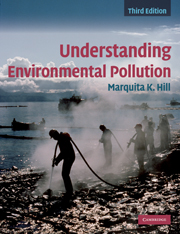Book contents
- Frontmatter
- Contents
- Preface
- Acknowledgements
- List of abbreviations and acronyms
- 1 Understanding pollution
- 2 Reducing risk, reducing pollution
- 3 Chemical toxicity
- 4 Chemical exposures and risk assessment
- 5 Air pollution
- 6 Acid deposition
- 7 Global climate change
- 8 Stratospheric ozone depletion
- 9 Water pollution
- 10 Drinking-water pollution
- 11 Solid waste
- 12 Hazardous waste
- 13 Energy
- 14 Persistent, bioaccumulative, and toxic
- 15 Metals
- 16 Pesticides
- 17 Pollution at home
- 18 Zero waste, zero emissions
- 19 Chemistry: some basic concepts
- Index
- References
13 - Energy
Published online by Cambridge University Press: 05 June 2012
- Frontmatter
- Contents
- Preface
- Acknowledgements
- List of abbreviations and acronyms
- 1 Understanding pollution
- 2 Reducing risk, reducing pollution
- 3 Chemical toxicity
- 4 Chemical exposures and risk assessment
- 5 Air pollution
- 6 Acid deposition
- 7 Global climate change
- 8 Stratospheric ozone depletion
- 9 Water pollution
- 10 Drinking-water pollution
- 11 Solid waste
- 12 Hazardous waste
- 13 Energy
- 14 Persistent, bioaccumulative, and toxic
- 15 Metals
- 16 Pesticides
- 17 Pollution at home
- 18 Zero waste, zero emissions
- 19 Chemistry: some basic concepts
- Index
- References
Summary
“Society can move to the next phase of the industrial revolution that runs without fossil fuels, or it can ignore the problem, sentencing humanity and other creatures to struggle on an increasingly desolate planet.”
Dr. James E. Hansen, director of the National Aeronautics & Space Administration's Goddard Institute of Space StudiesChapter 13 provides an overview of energy production and use as a major source of pollution, and how that pollution may be alleviated. Section I surveys world demand for energy. Section II concentrates on motor vehicle pollution and how we can reduce that pollution. Section III delves into pollution from electricity generation and use and means to reduce that pollution. Section IV briefly examines nuclear power. Section V summarizes renewable sources of energy. Finally Section VI looks at plans directed toward sustainable energy generation.
SECTION I
Energy demand, usage
Overviewing world energy use
The continuing increase in world energy demand is being viewed with alarm. Between 1970 and 1997 world energy consumption nearly doubled, and is projected to grow 57% between 2004 to 2030 (Figure 13.1). Worldwide, total energy use is projected to grow from 447 quadrillion British thermal units (Btu) in 2004 to 702 quadrillion Btu in 2030. In less-developed countries energy consumption is projected to rise three times as fast as in OECD countries. And as energy use increases, so does pollution.
- Type
- Chapter
- Information
- Understanding Environmental Pollution , pp. 374 - 409Publisher: Cambridge University PressPrint publication year: 2010



